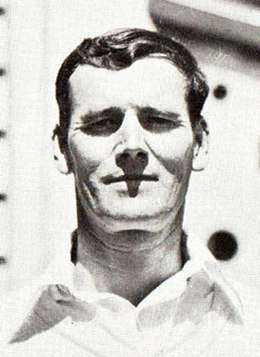Reg Read
Reginald John Read (born 8 June 1886, Auckland, New Zealand, died 1 March 1974, Christchurch, New Zealand) was a medium-pace bowler who played first-class cricket for Canterbury from 1904-05 to 1937-38.
 | |||||||||||||||||||||||||||
| Personal information | |||||||||||||||||||||||||||
|---|---|---|---|---|---|---|---|---|---|---|---|---|---|---|---|---|---|---|---|---|---|---|---|---|---|---|---|
| Full name | Reginald John Read | ||||||||||||||||||||||||||
| Born | 8 June 1886 Auckland, New Zealand | ||||||||||||||||||||||||||
| Died | 1 March 1974 (aged 87) Christchurch, New Zealand | ||||||||||||||||||||||||||
| Batting | Right-hand | ||||||||||||||||||||||||||
| Bowling | Right-arm medium pace | ||||||||||||||||||||||||||
| International information | |||||||||||||||||||||||||||
| National side | |||||||||||||||||||||||||||
| Domestic team information | |||||||||||||||||||||||||||
| Years | Team | ||||||||||||||||||||||||||
| 1904-05 to 1937-38 | Canterbury | ||||||||||||||||||||||||||
| Career statistics | |||||||||||||||||||||||||||
| |||||||||||||||||||||||||||
Source: CricketArchive, 2 April 2014 | |||||||||||||||||||||||||||
Playing career
Read made his first-class debut in Christchurch against the Australians at the age of 18 in February 1905, batting at number 11 and bowling only one over.[1] He played two matches in 1906-07 but was given only seven overs altogether, and did not take a wicket.[2]
He had to wait another 11 years for his next match. In 1917-18, for his Canterbury club Lancaster Park, he took 92 wickets in eight matches for 781 runs with his accurate medium-pace bowling,[3] and he returned to the Canterbury side at the age of 31. The Plunket Shield was still in its wartime hiatus, but there were several inter-provincial friendly matches. In his first match, against Otago, he took 3 for 58 and 2 for 35 (bowling throughout the innings) and made 18 and 34 not out to help Canterbury to victory.[4] In the next match he bowled through the entire Wellington first innings, taking 4 for 43 off 23 overs.[5] He remained in the Canterbury side, opening the bowling for more than ten years until his early forties.
In 1920-21, in what proved to be Southland's second-last first-class match, he took 7 for 35 and 7 for 24, bowling unchanged throughout the two innings.[6] In 1922-23, when Canterbury won the Plunket Shield, he was the leading bowler in the competition, with 20 wickets at an average of 18.40.[7] In the victory over Auckland that season he made his highest score, 50, then took 5 for 53 and 3 for 81.[8]
No one bettered his Plunket Shield tally of 19 wickets in 1926-27,[9] but at 40 he was overlooked when the team for New Zealand's first tour of England in 1927 was chosen. He was selected to play for New Zealand against the touring Australians in 1927-28, but took only two wickets in the two matches. By the time New Zealand played Test cricket for the first time, in 1930, he was no longer playing for Canterbury.
Read kept playing for Lancaster Park, on his way to a tally of around 1800 wickets in club cricket.[3] Without him, Canterbury won the Plunket Shield in 1934-35, but then did not win a match in 1935-36 or 1936-37, and for the 1937-38 season they brought Read back to open the bowling again at the age of 51. He took only four wickets in the three matches, and Canterbury finished last without a victory again, but his stamina was undiminished. In his final match he bowled 33.1 eight-ball overs, taking 1 for 102 as Auckland amassed 590.[10]
In his first first-class match Read played against Syd Gregory, whose first-class career began in 1890; in his last match he played against Merv Wallace, whose first-class career ended in 1961. Dick Brittenden said of Read: "From a run of about eight yards, he bowled medium-paced out-swingers and off-breaks ... his mastery of length and direction was absolute ... Read was one of the fittest cricketers ever to put on a pad."[3]
Personal life
Read worked as a foreman in a Christchurch foundry.[3] Later he retired to live in Kaikoura.[3]
References
- Canterbury v Australians 1904-05
- Reg Read bowling by season
- Dick Brittenden, New Zealand Cricketers, A.H. & A.W. Reed, Wellington, 1961, pp. 140–42.
- Canterbury v Otago 1917-18
- Canterbury v Wellington 1917-18
- Southland v Canterbury 1920-21
- Bowling in Plunket Shield 1922-23
- Canterbury v Auckland 1922-23
- Bowling in Plunket Shield 1926-27
- Auckland v Canterbury 1937-38